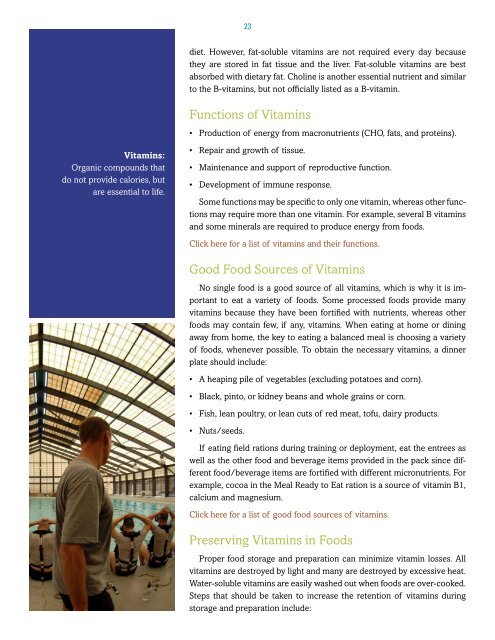special-operations-nutrition-guide
special-operations-nutrition-guide
special-operations-nutrition-guide
You also want an ePaper? Increase the reach of your titles
YUMPU automatically turns print PDFs into web optimized ePapers that Google loves.
23<br />
diet. However, fat-soluble vitamins are not required every day because<br />
they are stored in fat tissue and the liver. Fat-soluble vitamins are best<br />
absorbed with dietary fat. Choline is another essential nutrient and similar<br />
to the B-vitamins, but not officially listed as a B-vitamin.<br />
Functions of Vitamins<br />
• Production of energy from macronutrients (CHO, fats, and proteins).<br />
Vitamins:<br />
Organic compounds that<br />
do not provide calories, but<br />
are essential to life.<br />
• Repair and growth of tissue.<br />
• Maintenance and support of reproductive function.<br />
• Development of immune response.<br />
Some functions may be specific to only one vitamin, whereas other functions<br />
may require more than one vitamin. For example, several B vitamins<br />
and some minerals are required to produce energy from foods.<br />
Click here for a list of vitamins and their functions.<br />
Good Food Sources of Vitamins<br />
No single food is a good source of all vitamins, which is why it is important<br />
to eat a variety of foods. Some processed foods provide many<br />
vitamins because they have been fortified with nutrients, whereas other<br />
foods may contain few, if any, vitamins. When eating at home or dining<br />
away from home, the key to eating a balanced meal is choosing a variety<br />
of foods, whenever possible. To obtain the necessary vitamins, a dinner<br />
plate should include:<br />
• A heaping pile of vegetables (excluding potatoes and corn).<br />
• Black, pinto, or kidney beans and whole grains or corn.<br />
• Fish, lean poultry, or lean cuts of red meat, tofu, dairy products.<br />
• Nuts/seeds.<br />
If eating field rations during training or deployment, eat the entrees as<br />
well as the other food and beverage items provided in the pack since different<br />
food/beverage items are fortified with different micronutrients. For<br />
example, cocoa in the Meal Ready to Eat ration is a source of vitamin B1,<br />
calcium and magnesium.<br />
Click here for a list of good food sources of vitamins.<br />
Preserving Vitamins in Foods<br />
Proper food storage and preparation can minimize vitamin losses. All<br />
vitamins are destroyed by light and many are destroyed by excessive heat.<br />
Water-soluble vitamins are easily washed out when foods are over-cooked.<br />
Steps that should be taken to increase the retention of vitamins during<br />
storage and preparation include:


